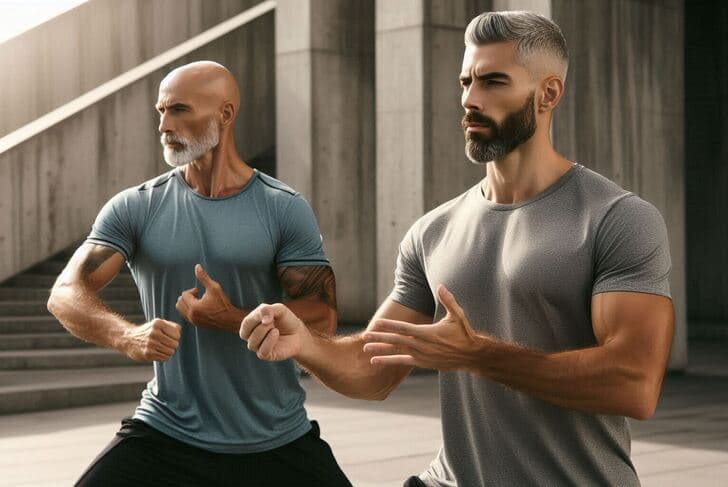As we hit our 40s and 50s, our joints often start whispering (or sometimes yelling) complaints about wear and tear, stiffness, or that creaky knee that shows up uninvited. Yet, these gentle exercises aren’t just about moving slowly; they quietly revolutionize how your joints feel and function, reducing pain and boosting mobility in ways that seem almost magical.
Imagine your invincible joints, not just surviving but thriving, as you sway through Tai Chi or stride with poles in Nordic Walking. You’ll see why these activities are game-changers for keeping your body limber and lively well into your later years.
Why Joint Health Matters More Than You Think in Middle Age
Your joints aren’t just hinges; they’re the unsung heroes that keep you bending, twisting, and strutting through life without a hitch. In middle age, cartilage starts thinning, inflammation creeps in, and everyday movements can feel like a chore if your joints aren’t happy.
What’s wild is that low-impact exercises like Tai Chi and Nordic Walking don’t just patch things up; they actively rebuild your joint resilience, making them more supple and less prone to injury. These activities work by lubricating joints, strengthening surrounding muscles, and improving circulation, which sounds simple but has a cascading effect on your overall health. You’ll be amazed at how a few deliberate movements can turn back the clock on joint stiffness and soreness.
- Start with Tai Chi’s flowing motions to wake up your joints. These graceful movements increase synovial fluid, which cushions your joints and reduces friction during movement. Regular practice helps your knees, hips, and shoulders move smoother, like oiling a rusty gate.
- Try Nordic Walking to evenly distribute weight and ease joint stress. Using poles takes pressure off your knees and hips while engaging your upper body, creating a full-body workout that doesn’t overwhelm your joints. This method strengthens the muscles around your joints, giving better support and stability over time.
- Incorporate Tai Chi’s meditative aspect to reduce joint inflammation. The slow, intentional movements paired with deep breathing lower stress hormones, which directly impact inflammation levels in your joints. Less inflammation means less swelling and pain, letting your joints recover and function better daily.
- Use Nordic Walking on varied terrains to challenge joints safely. Walking on grass, gravel, or soft trails with poles builds joint adaptability without risking strain, as the poles absorb some impact. This variety keeps your joints responsive and resilient, ready for whatever your day throws at them.
The Science Behind Low-Impact Exercise and Joint Magic
Believe it or not, your joints love a good low-impact workout because it tricks them into healing without the harsh pounding of high-intensity exercise.
Studies show that Tai Chi improves joint flexibility by up to 30% in just a few months, thanks to its focus on range of motion and muscle engagement. Nordic Walking, on the other hand, reduces joint load by distributing force through the poles, which means your knees and hips aren’t bearing the brunt of every step.
What’s even crazier is how these exercises boost proprioception - your body’s awareness of joint position - making you less likely to trip or twist something awkwardly. Your joints become smarter, stronger, and more cooperative, which is a revelation for anyone who thought middle age meant inevitable decline.
- Practice Tai Chi in a park to improve joint lubrication naturally. The outdoor setting encourages deeper breathing and relaxation, which enhances blood flow to your joints, delivering nutrients that keep cartilage healthy. Consistent sessions help your joints move freely, as if they’ve been given a new lease on life.
- Take Nordic Walking routes with gentle hills to strengthen joint support. The slight incline forces your muscles to work harder while the poles stabilize your joints, preventing overextension or strain. This builds a protective shield around your joints, making them less vulnerable to everyday wear.
- Schedule Tai Chi sessions early in the morning to kickstart joint mobility. Morning stiffness often plagues middle-aged joints, but Tai Chi’s slow stretches warm up your body, reducing stiffness and preparing your joints for the day ahead. Your joints will feel looser and more responsive, almost like they’re waking up refreshed.
- Choose Nordic Walking on flat surfaces initially to build confidence in your joints. The even terrain allows your joints to adapt to the poles’ support without added stress, gradually increasing their strength and flexibility. This builds a foundation for tackling tougher terrains later, with joints that are ready and willing.
How Tai Chi Turns Back Time for Your Joints
Tai Chi isn’t just some ancient dance; it’s a joint-rejuvenating miracle that feels like you’re hitting a reset button on your body. Each movement is designed to stretch and strengthen without jarring your joints, almost as if your body is being recalibrated for peak performance.
What’s astonishing is how Tai Chi’s weight-shifting techniques distribute pressure evenly, so no single joint takes the hit, unlike running or jumping. Your knees, hips, and spine start working in harmony, reducing the risk of arthritis flare-ups and keeping pain at bay. It’s like your joints are getting a spa day and a workout all at once, leaving them happier and healthier than you ever thought possible.
- Follow a Tai Chi routine that includes the wave hands like clouds move. This motion rotates your shoulders and hips gently, easing tension and improving joint mobility in areas that often stiffen with age. Your joints gain a newfound fluidity, making daily tasks like reaching or turning effortless.
- Add the repulse monkey step to target knee and hip health specifically. This forward-backward motion strengthens the muscles around your knees and hips, providing a natural brace that reduces wear and tear. Your joints feel supported and stable, as if they’ve been reinforced from the inside out.
- Join a Tai Chi class that focuses on the golden rooster stands on one leg pose. Balancing on one leg at a time strengthens ankle joints and improves overall joint coordination, reducing the likelihood of falls or injuries. Your joints become more agile, ready to handle sudden movements with ease.
- Practice Tai Chi near water to amplify joint relaxation. The calming sound and sight of water lower stress, which in turn reduces joint inflammation and stiffness, letting your body recover faster. Your joints respond by moving more freely, as if they’ve shed years of tension in just one session.
Nordic Walking: The Unsuspected Joint Protector
Nordic Walking might look like a brisk stroll with sticks, but it’s a stealthy joint savior that works wonders without you even realizing it. The poles act like shock absorbers, taking up to 30% of the impact off your lower joints, which is huge when you consider how much stress each step puts on your knees and hips. The exercise engages your upper body, creating a symphony of movement that supports your joints from head to toe.
Your joints get a break from being the sole weight-bearers, and the result is less pain, better alignment, and a spring in your step that you thought was long gone. It’s like giving your joints a vacation while still keeping them active and strong.
- Walk with Nordic poles along a riverbank to ease joint pressure. The soft ground reduces impact on your joints, while the poles distribute weight evenly, sparing your knees and hips from excessive strain. Your joints feel lighter and more energized, as if they’re gliding instead of grinding.
- Use Nordic Walking to explore local parks and keep joints active. The varied scenery keeps you motivated, while the poles ensure your joints aren’t overworked, maintaining their strength and flexibility. Your joints thrive on this gentle activity, staying supple and ready for more.
- Schedule Nordic Walking sessions during sunset for optimal joint recovery. The cooler temperatures and relaxed pace allow your joints to warm up slowly, reducing stiffness and promoting healing after a long day. Your joints respond with less soreness and greater range of motion, almost like they’re rejuvenated.
- Choose Nordic Walking routes with occasional stops to stretch joints. Pausing to stretch your arms, legs, and back with the poles’ support prevents joint stiffness from setting in during longer walks. Your joints stay loose and limber, prepared for whatever activity comes next without complaint.
Best Seller: Xtend BCAA + Recovery

We earn a commission if you click this link and make a purchase at no additional cost to you.
Wrapping Up: Your Joints Deserve This Revelation
So, there you have it - Tai Chi and Nordic Walking aren’t just gentle pastimes; they’re secret weapons for keeping your joints youthful and pain-free in middle age. These activities don’t scream for attention, but their effects on your joint health are nothing short of astonishing, from better mobility to reduced inflammation and beyond.
You’ll find yourself moving with a grace and ease you might have forgotten was possible, all thanks to a few simple, deliberate movements. Give them a try, and watch as your joints not only survive but flourish, proving that middle age can be a time of strength and vitality, not just decline.



